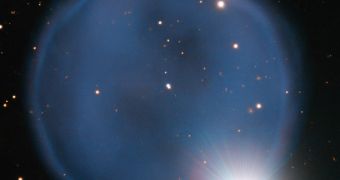Astronomers with the European Southern Observatory's (ESO) Very Large Telescope (VLT) were recently able to snap an amazing new image of a planetary nebula called PN A66 33, which is also known as Abell 33. This structure is famous for looking a lot like an engagement ring, and the new photograph shows exactly why that is.
The VLT, located at the Cerro Paranal Observatory in Chile's Atacama desert, uses four 8.2-meter (27-foot) main telescopes and four 1.8-meter (6-foot) auxiliary telescopes to image targets located extremely far away from Earth. From its vantage point in the Southern Hemisphere, the installation can accurately observe Abell 33. The latest image shows the dual nature of this object.
According to experts, the main component of the cosmic engagement ring is an emissions nebula (the round blue halo) made out of an expanding shell of glowing, ionized gas. This material was released from an old red giant-class star that died off some time ago. The diamond is in fact a star located much closer to Earth, which is by chance aligned with the more distant nebula.
Though Abell 33 is located around 2,500 light-years from our planet, the aligned star, called HD 83535, lies much nearer, just enough to create a spectacular view when the two are seen together. Slightly off-center in the nebula, you can observe the star that created the halo, which is currently on its way to turning into a white dwarf-class star. The same fate awaits the Sun in around 5 billion years, as well.

 14 DAY TRIAL //
14 DAY TRIAL //